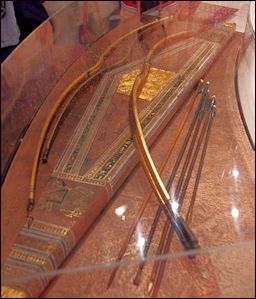Steven Lee
Blue Belt
https://upload.wikimedia.org/wikipe...yeo_Korean_sword_Hwando_(original_Katana).jpg
==Korean weapon martial arts predating Muyedobotongji & their efficiency==
In this section, we will observe the sources of some Muyedobotongji sports. First, we have to differentiate between Fight Games & martial arts. The distinction is simple. East Asia's martial arts typically refer to an art form, typically doing Kata in the air. Fight Games are meant to be games fighting each other with no regards to being an artful form such as fencing. There is coaching how to do the game better, but there's no art form unlike typical East Asian martial art. There are only gaming, coaching, training with knowhow how to move. Also differentiate weapon training from weapon arts. The distinction is simply whether you teach the knowhow how to wield a weapon (or in barehand) or if it is in an art form. Korean historically didn't have weapon martial arts but only had weapon Fight Games & weapon training (coaching knowhow how to move with no regard to an art form) such as Kapeulchang, Samgapchang, Gyukgum, etc.
https://i.imgur.com/n4l6wi9.png
https://i.imgur.com/8lqczzp.png
https://i.imgur.com/w4tECE4.png
https://i.imgur.com/KEkyMWq.png
https://i.imgur.com/1dI67r7.png
https://i.imgur.com/LPOeChg.png
Even the name Bongookgum shows in Korean historical records before Muyedobotongji. "당장 본국검이라고 하는 명칭만 해도 승정원일기에 따르면 ‘현종 14년 3월 11일(1673년)’자 기사에서 기타 기예들과 함께 시험을 친 기록이 남아 있다." Translation: "Even for the name Bongookgum, it shows in Seungjungwonilgi 1673's record, taking an exam in Bongookgum among with other sports."
http://www.mooye.net/14319
This was before the time of Muyedobotongji. Chosunsebub is a Chinese invention based on observing Korean Bongookgum, but Bongookgum is a traditional techniques. Historically, Korean has successfully managed sword fights & spear fights using such weapon Fight Games & weapon training (weapon training doesn't necessarily need an art form but just coaching knowhow). For example, during Imjin War, Korea has successfully won sword fights & spear fights against Japan.
https://i.imgur.com/ypwW6AH.jpg
https://i.imgur.com/cMVeu9q.jpg
https://i.imgur.com/Kg47IIF.jpg
There are also other victories such as Sieon Lee chasing then defeating Japanese army in 1593 during Imjin War. In 1605, Sieon Lee also reported that Japanese are fancy with sword techniques but Koreans can win against them in sword fights. The main problem against Japan discussed was Japan's guns. Sieon Lee reported that Japanese sword soldiers only like to charge forward after Koreans were already dying or running away (from guns).
https://pbs.twimg.com/media/CuQWBaGWYAQioet.jpg
Korean weapon arts in Muyedobotongji (most of those Muyedobotongji sports come from the traditional Korean Fight Games, coaching, knowhow, training before Muyedobotongji) don't use strikes such as punching cause those sports historically have been sufficient in winning even without doing such. Korean had good efficient weapon training & knowhow without art form (no martial art but training & coaching) making results before Muyedobotongji.
==Korean weapon martial arts predating Muyedobotongji & their efficiency==
In this section, we will observe the sources of some Muyedobotongji sports. First, we have to differentiate between Fight Games & martial arts. The distinction is simple. East Asia's martial arts typically refer to an art form, typically doing Kata in the air. Fight Games are meant to be games fighting each other with no regards to being an artful form such as fencing. There is coaching how to do the game better, but there's no art form unlike typical East Asian martial art. There are only gaming, coaching, training with knowhow how to move. Also differentiate weapon training from weapon arts. The distinction is simply whether you teach the knowhow how to wield a weapon (or in barehand) or if it is in an art form. Korean historically didn't have weapon martial arts but only had weapon Fight Games & weapon training (coaching knowhow how to move with no regard to an art form) such as Kapeulchang, Samgapchang, Gyukgum, etc.
https://i.imgur.com/n4l6wi9.png
https://i.imgur.com/8lqczzp.png
https://i.imgur.com/w4tECE4.png
https://i.imgur.com/KEkyMWq.png
https://i.imgur.com/1dI67r7.png
https://i.imgur.com/LPOeChg.png
Even the name Bongookgum shows in Korean historical records before Muyedobotongji. "당장 본국검이라고 하는 명칭만 해도 승정원일기에 따르면 ‘현종 14년 3월 11일(1673년)’자 기사에서 기타 기예들과 함께 시험을 친 기록이 남아 있다." Translation: "Even for the name Bongookgum, it shows in Seungjungwonilgi 1673's record, taking an exam in Bongookgum among with other sports."
http://www.mooye.net/14319
This was before the time of Muyedobotongji. Chosunsebub is a Chinese invention based on observing Korean Bongookgum, but Bongookgum is a traditional techniques. Historically, Korean has successfully managed sword fights & spear fights using such weapon Fight Games & weapon training (weapon training doesn't necessarily need an art form but just coaching knowhow). For example, during Imjin War, Korea has successfully won sword fights & spear fights against Japan.
https://i.imgur.com/ypwW6AH.jpg
https://i.imgur.com/cMVeu9q.jpg
https://i.imgur.com/Kg47IIF.jpg
There are also other victories such as Sieon Lee chasing then defeating Japanese army in 1593 during Imjin War. In 1605, Sieon Lee also reported that Japanese are fancy with sword techniques but Koreans can win against them in sword fights. The main problem against Japan discussed was Japan's guns. Sieon Lee reported that Japanese sword soldiers only like to charge forward after Koreans were already dying or running away (from guns).
https://pbs.twimg.com/media/CuQWBaGWYAQioet.jpg
Korean weapon arts in Muyedobotongji (most of those Muyedobotongji sports come from the traditional Korean Fight Games, coaching, knowhow, training before Muyedobotongji) don't use strikes such as punching cause those sports historically have been sufficient in winning even without doing such. Korean had good efficient weapon training & knowhow without art form (no martial art but training & coaching) making results before Muyedobotongji.

